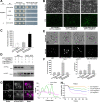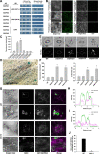The Arabidopsis Rab protein RABC1 affects stomatal development by regulating lipid droplet dynamics
- PMID: 35929087
- PMCID: PMC9614440
- DOI: 10.1093/plcell/koac239
The Arabidopsis Rab protein RABC1 affects stomatal development by regulating lipid droplet dynamics
Abstract
Lipid droplets (LDs) are evolutionarily conserved organelles that serve as hubs of cellular lipid and energy metabolism in virtually all organisms. Mobilization of LDs is important in light-induced stomatal opening. However, whether and how LDs are involved in stomatal development remains unknown. We show here that Arabidopsis thaliana LIPID DROPLETS AND STOMATA 1 (LDS1)/RABC1 (At1g43890) encodes a member of the Rab GTPase family that is involved in regulating LD dynamics and stomatal morphogenesis. The expression of RABC1 is coordinated with the different phases of stomatal development. RABC1 targets to the surface of LDs in response to oleic acid application in a RABC1GEF1-dependent manner. RABC1 physically interacts with SEIPIN2/3, two orthologues of mammalian seipin, which function in the formation of LDs. Disruption of RABC1, RABC1GEF1, or SEIPIN2/3 resulted in aberrantly large LDs, severe defects in guard cell vacuole morphology, and stomatal function. In conclusion, these findings reveal an aspect of LD function and uncover a role for lipid metabolism in stomatal development in plants.
© American Society of Plant Biologists 2022. All rights reserved. For permissions, please email: journals.permissions@oup.com.
Figures







Similar articles
-
RABC1-ABI1 module coordinates lipid droplet mobilization and post-germination growth arrest in Arabidopsis.Cell Rep. 2025 May 27;44(5):115655. doi: 10.1016/j.celrep.2025.115655. Epub 2025 May 3. Cell Rep. 2025. PMID: 40323720
-
Arabidopsis SEIPIN Proteins Modulate Triacylglycerol Accumulation and Influence Lipid Droplet Proliferation.Plant Cell. 2015 Sep;27(9):2616-36. doi: 10.1105/tpc.15.00588. Epub 2015 Sep 11. Plant Cell. 2015. PMID: 26362606 Free PMC article.
-
SEIPIN Proteins Mediate Lipid Droplet Biogenesis to Promote Pollen Transmission and Reduce Seed Dormancy.Plant Physiol. 2018 Feb;176(2):1531-1546. doi: 10.1104/pp.17.01430. Epub 2017 Dec 4. Plant Physiol. 2018. PMID: 29203558 Free PMC article.
-
Growth, fusion and degradation of lipid droplets: advances in lipid droplet regulatory protein.Arch Physiol Biochem. 2025 Apr;131(2):109-118. doi: 10.1080/13813455.2024.2388779. Epub 2024 Aug 8. Arch Physiol Biochem. 2025. PMID: 39115279 Review.
-
Rab proteins as regulators of lipid droplet formation and lipolysis.Cell Biol Int. 2016 Oct;40(10):1026-32. doi: 10.1002/cbin.10650. Epub 2016 Sep 5. Cell Biol Int. 2016. PMID: 27453349 Review.
Cited by
-
Plasticity of the Arabidopsis leaf lipidome and proteome in response to pathogen infection and heat stress.Plant Physiol. 2025 Feb 7;197(2):kiae274. doi: 10.1093/plphys/kiae274. Plant Physiol. 2025. PMID: 38781317 Free PMC article.
-
Autophagosome biogenesis and organelle homeostasis in plant cells.Plant Cell. 2024 Sep 3;36(9):3009-3024. doi: 10.1093/plcell/koae099. Plant Cell. 2024. PMID: 38536783 Free PMC article. Review.
-
Expression dynamics and a loss-of-function of Arabidopsis RabC1 GTPase unveil its role in plant growth and seed development.Planta. 2023 Mar 29;257(5):89. doi: 10.1007/s00425-023-04122-2. Planta. 2023. PMID: 36988700
-
Genome-Wide Association and RNA-Seq Analyses Reveal a Potential Candidate Gene Related to Oil Content in Soybean Seeds.Int J Mol Sci. 2024 Jul 25;25(15):8134. doi: 10.3390/ijms25158134. Int J Mol Sci. 2024. PMID: 39125702 Free PMC article.
-
Lipid droplets are versatile organelles involved in plant development and plant response to environmental changes.Front Plant Sci. 2023 Jun 23;14:1193905. doi: 10.3389/fpls.2023.1193905. eCollection 2023. Front Plant Sci. 2023. PMID: 37426978 Free PMC article. Review.
References
-
- Antonny B, Madden D, Hamamoto S, Orci L, Schekman R (2001) Dynamics of the COPII coat with GTP and stable analogues. Nat Cell Biol 3: 531–537 - PubMed
-
- Bekbulat F, Schmitt D, Feldmann A, Huesmann H, Eimer S, Juretschke T, Beli P, Behl C, Kern A (2020) RAB18 loss interferes with lipid droplet catabolism and provokes autophagy network adaptations. J Mol Biol 432: 1216–1234 - PubMed
Publication types
MeSH terms
Substances
LinkOut - more resources
Full Text Sources
Molecular Biology Databases
Research Materials

